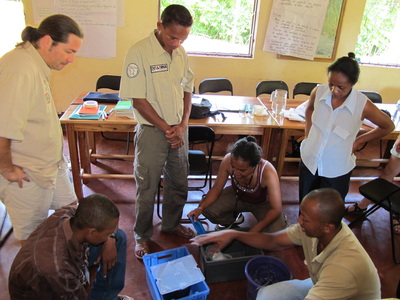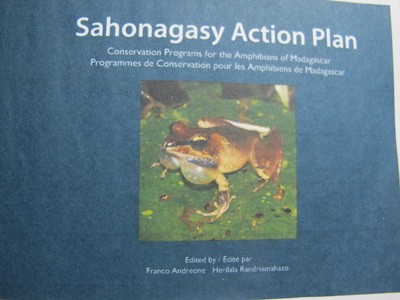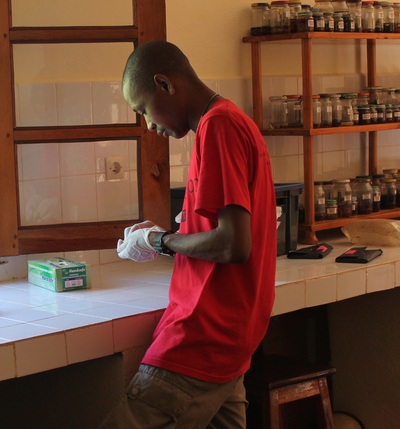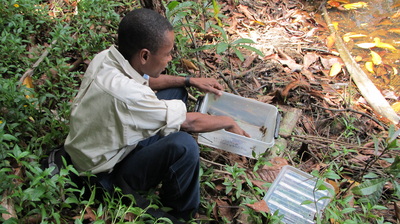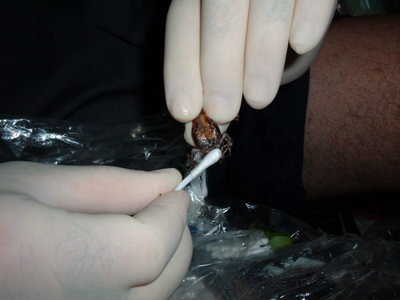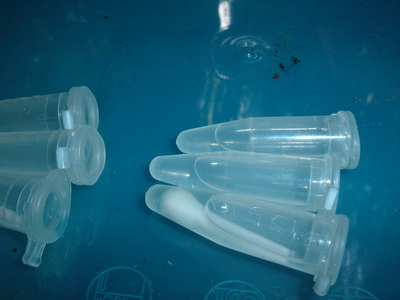Amphibian Conservation
Amphibians are considered the most endangered vertebrates in the world with one third of all species threatened and over 40% of the existing populations declining in numbers. Habitat destruction is the leading cause for declining populations but invasive species, the pet trade, hunting, pollution, diseases and climate change also play a role in their decline.
In 2005 the IUCN SSC held an Amphibian Conservation Summit which resulted in the 2007 publication of the Amphibian Conservation Action Plan. In 2006 the IUCN Amphibian Specialist Group - Madagascar, Chaired by Dr. Franco Andreone, held a workshop to develop a conservation strategy for Madagascar's amphibians which was attended by Karen Freeman and Jean Noel. The Sahonagasy Action Plan (Sahona is frog in Malagasy and "gasy" refers to " Malagasy") was published in 2008.
In 2005 the IUCN SSC held an Amphibian Conservation Summit which resulted in the 2007 publication of the Amphibian Conservation Action Plan. In 2006 the IUCN Amphibian Specialist Group - Madagascar, Chaired by Dr. Franco Andreone, held a workshop to develop a conservation strategy for Madagascar's amphibians which was attended by Karen Freeman and Jean Noel. The Sahonagasy Action Plan (Sahona is frog in Malagasy and "gasy" refers to " Malagasy") was published in 2008.
Chytrid surveillance program
One disease, chytridiomycosis, has had devastating effects on some species. Caused by the fungus Batrachochytrium dendrobayidis, chytrid is only
pathogenic to amphibians. However, experience has shown suseptibility is not consistent across species; some taxa are resistant to infection, others are infected without effect and become disease vectors but for some species the disease is fatal. The 2008 Sahonagasy Action Plan recommended a chytrid disease screening program to alert conservation bodies and government authorities in the event of the disease's arrival. Parc Ivoloina was selected as one of eight sites. Prior to initiating the screening program, designated screeners were trained at the November 2010 Amphibian Disease Screening course held at Parc Ivoloina. Participants were shown proper techniques for capturing, holding and swabbing frogs as well as biosecurity measures to prevent the inadvertent transmission of disease between frogs or other sites they visit.
pathogenic to amphibians. However, experience has shown suseptibility is not consistent across species; some taxa are resistant to infection, others are infected without effect and become disease vectors but for some species the disease is fatal. The 2008 Sahonagasy Action Plan recommended a chytrid disease screening program to alert conservation bodies and government authorities in the event of the disease's arrival. Parc Ivoloina was selected as one of eight sites. Prior to initiating the screening program, designated screeners were trained at the November 2010 Amphibian Disease Screening course held at Parc Ivoloina. Participants were shown proper techniques for capturing, holding and swabbing frogs as well as biosecurity measures to prevent the inadvertent transmission of disease between frogs or other sites they visit.
Parc Ivoloina, located 14 kms from Toamasina, Madagascar’s
largest and busiest port and primary importation route for shipping freight to
the country. Despite consisting of primarily secondary and plantation forest,
Ivoloina is home to more than 30 frog species and provides an easily-accessible
site, ideal for long-term chytrid surveillance. As the most visited tourist
destination near Toamasina Madagascar, Parc Ivoloina is also a high risk site
for the potential introduction of chytrid.
In 2010, Parc Ivoloina welcomed 19,000 visitors of which 4,000 were foreigners,
many of whom have visited other wildlife viewing sites.
Jean Noel, the MFG’s herpetologist has headed up the chytrid screening program at Ivoloina. Frogs are surveyed twice yearly, once during the rainy season (January-April) and once in the dry season (July-August). The objective is to sample a total of 50 individual frogs of two species; at Ivoloina the two species are Mantidactylus betsileanus (40 samples) and Ptychadena mascareniensis (10 samples). Swab collection protocol involves using a sterile cotton swab which is run across the feet, legs, and drink patch of each frog in a standardized manner. The samples are individually labeled with species name, collection date and GPS location and stored until they are sent to a lab in Italy for analysis.
Unfortunately, it was confirmed in 2013 that chytrid is present in Madagascar. How chytrid is impacting Malagasy frog species in the wild is being studied and an innovative project evaluating the efficacy of probiotics to reduce the negative consequences of the disease is underway. The MFG will continue its important work surveying for the presence of chytrid in Toamasina which has now been extended to sampling the newest conservation threat - the invasive Asian toad.
Jean Noel, the MFG’s herpetologist has headed up the chytrid screening program at Ivoloina. Frogs are surveyed twice yearly, once during the rainy season (January-April) and once in the dry season (July-August). The objective is to sample a total of 50 individual frogs of two species; at Ivoloina the two species are Mantidactylus betsileanus (40 samples) and Ptychadena mascareniensis (10 samples). Swab collection protocol involves using a sterile cotton swab which is run across the feet, legs, and drink patch of each frog in a standardized manner. The samples are individually labeled with species name, collection date and GPS location and stored until they are sent to a lab in Italy for analysis.
Unfortunately, it was confirmed in 2013 that chytrid is present in Madagascar. How chytrid is impacting Malagasy frog species in the wild is being studied and an innovative project evaluating the efficacy of probiotics to reduce the negative consequences of the disease is underway. The MFG will continue its important work surveying for the presence of chytrid in Toamasina which has now been extended to sampling the newest conservation threat - the invasive Asian toad.

